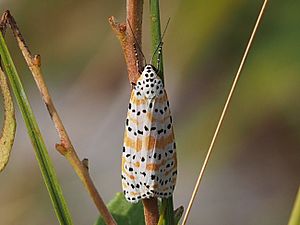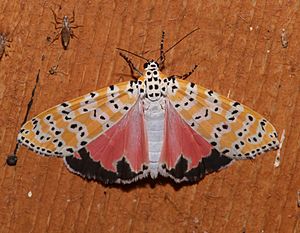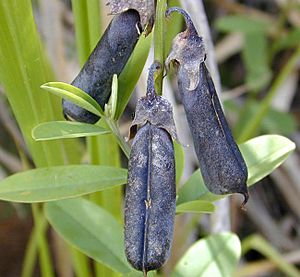Ornate bella moth facts for kids
Quick facts for kids Ornate bella moth |
|
|---|---|
 |
|
 |
|
| Scientific classification | |
| Synonyms | |
|
The bella moth, also known as the ornate moth or rattlebox moth, is a type of moth. Its scientific name is Utetheisa ornatrix. These moths are brightly colored with pink, red, orange, yellow, or white wings. They have black patterns on their wings.
The bella moth has a wingspan of about 33 to 46 millimeters. You can find them in the central and eastern parts of North America. They also live throughout Mexico and other parts of Central America. Unlike most moths, the bella moth is active during the day. This means it is diurnal.
Long ago, the bella moth from eastern North America was called Utetheisa bella. Now, scientists have grouped it with Utetheisa ornatrix. The caterpillars of these moths usually eat Crotalaria plants. These plants have poisonous compounds called alkaloids. These chemicals make the caterpillars taste bad to most animals that might want to eat them. Sometimes, the caterpillars might even eat other bella moth larvae. This helps them get enough of these protective chemicals.
Contents
Where Bella Moths Live
You can find the Utetheisa ornatrix in the southeastern United States. Their range goes from Connecticut to southeastern Nebraska and south to New Mexico and Florida. They are more common in the southern areas. This is because their favorite food plant grows more there. They also live all over Mexico, South America, and Central America.
Bella Moth Family Tree
In 1758, a scientist named Carl Linnaeus first described two types of moths. He called the paler ones Phalaena ornatrix. He named the bright pink ones Utetheisa bella. Later, in 1819, another scientist moved these moths to a new group called Utetheisa.
For a long time, it was hard to figure out how these moths were related. Researchers looked at how they looked, like their colors and shapes. This caused a lot of confusion. In 1960, Forbes decided that Utetheisa ornatrix and Utetheisa bella were actually the same species. He called them all Utetheisa ornatrix. Other scientists later used genetic tests to agree with this idea. They found that differences in how the moths looked were due to where they lived.
Bella Moth Subspecies
- Utetheisa ornatrix ornatrix
- Utetheisa ornatrix bella (Linnaeus, 1758)
- Utetheisa ornatrix saintcroixensis Pease, 1973
Life Cycle of the Bella Moth
Eggs
The eggs of the bella moth are round. They can be white or yellow.
Larvae (Caterpillars)
The caterpillars are orange and brown. They have black bands on each part of their body. These black bands also have clear white spots. When fully grown, the caterpillars are about 30 to 35 millimeters long.
Pupae
The pupae are mostly black with orange and brown bands. A loose layer of silk usually covers the pupae.
Adult Moths
Adult bella moths are brightly colored. This is a warning sign to predators. Their wings can be yellow, red, pink, orange, or white. They have white bands with black spots on their wings. The back wings can be bright pink with a black edge. Adult bella moths have a wingspan of 33 to 46 millimeters.
How Bella Moths Protect Themselves
When they are caterpillars, bella moths eat plants from the Crotalaria family. These plants have a lot of toxins called pyrrolizidine alkaloids (PAs). These toxins are especially strong in the plant's seeds. Bella moth caterpillars store these toxins in their bodies. This makes them taste bad to animals that might try to eat them.
When an adult moth is bothered, it can release a foamy liquid from its head. This foam contains the toxins. This also makes them taste bad to predators. Because these PAs are so useful, caterpillars sometimes fight over who gets to eat a seed pod. Caterpillars that cannot get a pod must eat leaves. Leaves have much less of these chemicals. These caterpillars have fewer PAs and are more likely to be eaten.
Caterpillars do not go into the seed pods right after they hatch. For the first few stages of their life, they eat leaves. They only enter the pods when they are a bit older. When caterpillars change into adult moths, they still have the alkaloids. These chemicals keep protecting them as adults.
PAs make the bella moth taste bad to many animals that hunt them. This includes spiders and insectivorous bats. Spiders that catch bella moth caterpillars or adults usually let them go quickly. The moths are not harmed. Bats also let go of bella moths without hurting them. Unlike some other moths, the bella moth does not make special sounds to warn bats away.
Bella moth caterpillars can handle PAs because they have a special gene. This gene helps them break down the toxins. When they eat more PAs, they use this gene more. Eating a lot of PAs does not hurt the moths. It only makes them take a bit longer to grow. But they still grow to the same size as moths that eat less PAs.
Caterpillar Cannibalism
Sometimes, bella moth caterpillars eat other bella moth eggs, pupae, or larvae. This happens because PAs are a limited resource. Some caterpillars might not get enough PAs from plants. So, they might eat other bella moths to get the chemicals they need. This behavior is usually because they need more PAs, not because they are hungry.
Eating pupae is rare because caterpillars usually move away from the plant to become pupae. Eating eggs is also rare. Eggs do not have many PAs, and eggs from the same group usually hatch at the same time. Eating another caterpillar that has a lot of PAs is more common. Eating just one caterpillar can give a hungry caterpillar enough PAs.
Kin Recognition
Bella moth caterpillars might be able to tell if other caterpillars are their siblings. Caterpillars are less likely to try to take over a seed pod if their brothers or sisters are already inside.
Bella Moth Reproduction
Bella moths have interesting ways of reproducing. Female moths mate many times during their three to four-week adult life. On average, they mate with three to four males. Each male gives the female a special gift. This gift is called a spermatophore. It contains sperm, nutrients, and the protective alkaloids.
Male moths put a lot of energy into this gift. It can be up to 11% of their body weight. The nutrients in the spermatophore help the female produce about 32 more eggs.
Mating Habits
Female bella moths mate with several males. This is called a polyandrous mating system. Females usually mate with four to five males during their lives. They can even receive up to thirteen spermatophores. Since spermatophores contain nutrients and pyrrolizidine alkaloids (PAs), mating many times helps the female have healthier offspring.
Mating multiple times also helps the female directly. The spermatophores are quite large. The female can digest them to get more resources. This helps her make more eggs, increasing her egg production by about 15%. Also, mating with many males means more of the alkaloid gifts get passed to the eggs. The PAs from different males mix together. This means eggs usually get PAs from more than one male. However, most of the sperm used to fertilize the eggs usually comes from just one male.
Bella Moth Food Plants
Plants from the Crotalaria group are the main food for the Utetheisa ornatrix. Other plants in the Fabaceae family are also sometimes eaten. The name Crotalaria comes from a Greek word meaning "a rattle." This refers to the seed pods on these plants, which can rattle.
The Crotalaria plants contain pyrrolizidine alkaloids. The bella moth uses these chemicals to keep predators away. Some specific host plants include:
- Crotalaria avonensis (Avon Park rattlebox)
- Crotalaria rotundifolia (rabbitbells)
- Crotalaria lanceolata
- Crotalaria pallida (smooth rattlebox)
- Crotalaria spectabilis (showy rattlebox)
- Crotalaria retusa
Pyrrolizidine Alkaloids and People
Pyrrolizidine alkaloids (PAs) are the toxins that bella moths can eat and use for protection. These chemicals are found in some plants. If humans or other animals eat these plants, the PAs can cause health problems. People might come into contact with PAs if these plants grow in food crops. They can also be found in milk or honey from animals that ate these plants. Some traditional herbal medicines might also contain them.
If PAs are eaten, they mainly affect the liver and lungs.




